The Dominican Republic (/dəˈmɪnɪkən/də-MIN-ik-ən; Spanish: República Dominicana, articulated [reˈpuβlika ðominiˈkana] (sound speaker inconsistent)) is a nation situated on the island of Hispaniola in the Greater Antilles archipelago of the Caribbean area. It possesses the eastern five-eighths of the island, which it imparts to Haiti,[13][14] making Hispaniola one of just two Caribbean islands, alongside Saint Martin, that is shared by two sovereign states. The Dominican Republic is the second-biggest country in the Antilles by region (after Cuba) at 48,671 square kilometers (18,792 sq mi), and third-biggest by the populace, with around 10.8 million individuals (2020 est.), of whom roughly 3.3 million live in the metropolitan area of Santo Domingo, the capital city.[4][15][16] The authority language of the nation is Spanish.
The local Taíno individuals had occupied Hispaniola before the appearance of Europeans, isolating it into five chiefdoms.[4] They had built a high level cultivating and hunting society, and were currently turning into a coordinated civilization.[17] The Taínos likewise possessed Cuba, Jamaica, Puerto Rico, and the Bahamas. The Genoese sailor Christopher Columbus investigated and asserted the island for Castile, arriving there on his first journey in 1492. The province of Santo Domingo turned into the site of the first long-lasting European settlement in quite a while and the principal seat of Spanish pioneer rule in the New World. In 1697, Spain perceived French territory over the western third of the island, which turned into the autonomous province of Haiti in 1804.
After multiple hundred years of Spanish rule, the Dominican public pronounced freedom in November 1821. The head of the autonomy development, José Núñez de Cáceres, planned the Dominican country to join with the nation of Gran Colombia, however, the recently autonomous Dominicans were powerfully attached by Haiti in February 1822. Autonomy came 22 years after the fact in 1844,[4] after triumph in the Dominican War of Independence. Throughout the following 72 years, the Dominican Republic Golf Villa Luxury Rental experienced for the most part polite conflicts (supported with advances from European traders), a few bombed attacks by its neighbor, Haiti, and brief re-visitation of Spanish pilgrim status, before forever removing the Spanish during the Dominican War of Restoration of 1863-1865.[18][19][20] During this period, two presidents were killed (Ulises Heureaux in 1899 and Ramón Cáceres in 1911).
The U.S. involved the Dominican Republic (1916-1924) because of the dangers of defaulting on unfamiliar obligations; an ensuing quiet and prosperous six-year time span under Horacio Vásquez followed. From 1930 the tyranny of Rafael Leónidas Trujillo managed until his death in 1961.[4] Juan Bosch was chosen president in 1962 however was ousted in a tactical overthrow in 1963. A common conflict in 1965, the nation’s last, was finished by U.S. military mediation and was trailed by the tyrant rule of Joaquín Balaguer (1966-1978 and 1986-1996). Starting around 1978, the Dominican Republic has advanced toward agent democracy,[21] and has been driven by Leonel Fernández for more often than not after 1996. Danilo Medina succeeded Fernández in 2012, winning 51% of the discretionary vote over his adversary ex-president Hipólito Mejía. He was subsequently prevailed by Luis Abinader in the 2020 official political decision.
The Dominican Republic has the biggest economy (as per the U.S. State Department and the World Bank) in the Caribbean and Central American area and is the seventh-biggest economy in Latin America. Over the most recent 25 years, the Dominican Republic has had the quickest developing economy in the Western Hemisphere – with a normal genuine GDP development pace of 5.3% somewhere in the range between 1992 and 2018. GDP development in 2014 and 2015 came to 7.3 and 7.0%, individually, the most elevated in the Western Hemisphere.[25] In the main portion of 2016, the Dominican economy developed 7.4% proceeding with its pattern of fast monetary growth. Recent development has been driven by development, assembling, the travel industry, and mining. The nation is the site of the third biggest gold mine on the planet, the Pueblo Viejo mine. Private utilization has been solid, because of low expansion (under 1% on normal in 2015), work creation, and an elevated degree of settlements. Illicit Haitian movement is a major issue in the Dominican Republic, putting a strain on the Dominican economy and expanding pressures among Dominicans and Haitians. The Dominican Republic is additionally home to 114,050 unlawful workers from Venezuela.[4]
The Dominican Republic is the most visited objective in the Caribbean. The all-year fairways are major attractions.[35] A topographically assorted country, the Dominican Republic is home to both the Caribbean’s tallest mountain top, Pico Duarte, and the Caribbean’s biggest lake and absolute bottom, Lake Enriquillo. The island has a normal temperature of 26 °C (78.8 °F) and extraordinary climatic and natural diversity. The nation is additionally the site of the primary basilica, palace, cloister, and fort worked in the Americas, situated in Santo Domingo’s Colonial Zone, a World Heritage Site. Baseball is the true public sport.



Comment (0)